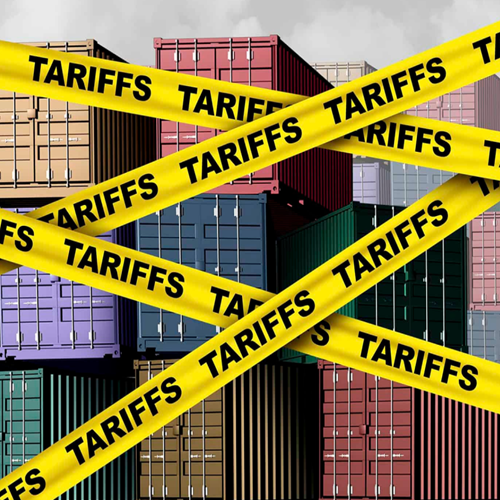Posted Mon, Mar 25, 2024 12:39 PM
NESG Issues a Policy Brief on the Status of Food Security in Nigeria

The Nigerian Economic Summit Group (NESG) recently issued a policy brief titled "Status of Food Security: Dimensioning the Crisis, Policy Options, and Strategic Responses." This brief outline urgent measures to address the current food crisis in Nigeria, aiming to develop a comprehensive approach to alleviate hunger and offer practical solutions.
In January 2024, Nigeria's food inflation surged to 35.41% from 33.9% in December 2023. The number of food-insecure Nigerians increased significantly, from 66.2 million in Q1 2023 to 100 million in Q1 2024 (WFP, 2024), with 18.6 million facing acute hunger and 43.7 million Nigerians showing crisis-level or above crisis-level hunger coping strategies as of March 2024. This unprecedented crisis demands immediate humanitarian, social protection, and food systems responses.
Despite a contraction in the Nigerian Agriculture Sector in 2023, resulting in reduced productivity, the nation is fortunate to face no climatic risks of famine or drought, as no part of Nigeria is categorised as High Risk or Moderate Risk and Deteriorating.
The ongoing crisis underscores the pivotal role of the NESG as the nation's foremost private-sector think tank. Historically, we have served as the Technical Partner to the Ministry of Finance, Budget, and Economic Planning, shaping the National Medium-Term Strategy for Agriculture and Food Security. Additionally, we have acted as Private Sector Advisor to the Presidential Taskforce on COVID-19 control and contributed to the Zero Hunger Roundtable throughout the pandemic. Post-COVID-19, our collaboration with the Bill and Melinda Gates Foundation facilitated the NESG-Bill and Melinda Gates supported the High-Level Forum on SDGs Nexus on Food Security, which has provided annual updates on food security challenges. In this policy brief, we consolidate invaluable multistakeholder perspectives, data analysis, and policy recommendations to address the current food crisis, drawing on institutional memory and insights to mobilise a comprehensive national response.
The National Food Systems Profile reveals critical institutional, policy and industrial coordination and governance gaps.
This reflects a fundamental and systemic challenge with National Food Systems vulnerabilities, which is not a new insight. NESG and other national stakeholders under the then Federal Ministry of Finance, Budget and National Planning supported the National Food Systems Assessment with the Food and Agriculture Organisation of the United Nations, the French Agricultural Research Centre for International Development, and the European Union in 2022. In the final report, "FOOD SYSTEMS PROFILE – NIGERIA: Catalysing the Sustainable and Inclusive Transformation of Food Systems," the key findings showed that Nigeria needed to apply urgency, tenacity, and a national state of emergency in dealing with the following:
a) Persistent Structural Vulnerabilities: The current socio-economic structure of Nigeria, characterised by high dependence on oil revenue and food imports to feed its people, high population growth, and urbanisation, which had been occurring for several decades, pose formidable challenges to the food system. Food imports have more than quadrupled in recent decades, from USD 964 million in 1995 to USD 4.57 billion in 2016, resulting in a substantial trade deficit for the agri-food sector. The most imported commodities are rice, wheat, milk and fish. While the food import bill eased to USD 1.908,748 in 2017 and USD 1.728,571 in 2018, It again scaled back to pre-2016 levels after the COVID-19 hunger response.
b) Continuing socio-economic vulnerabilities persist, with 133 million people experiencing extreme multidimensional poverty, characterised by significant regional disparities. For instance, in Sokoto state, poverty affects 81 percent of the population, while in Niger state, the poverty rate stands at 34 percent. Ongoing internal conflicts, elevated unemployment rates, and the impacts of climate change exacerbate these challenges.
Nigeria's Response Must Have a Food Systems Approach that Matches the Scale and Dimensions of the Food Value Chain Risks and Vulnerabilities.
According to the Medium-Term National Development Plan (2021-2025), Thematic Working Group, some critical indices are critical to food systems security response.
- Land Security: Of the 41% (34 million ha) of total arable land under cultivation, 30% of states experience insecurity of agricultural land, and 80% of farmers face climate-related hazards. Annual forest cover loss has been 2.5% in the last 15 years. The scale of land insecurity is aggravated by broad-based dynamics of armed groups from bandits, terrorists, political militias, community-based militias, and illicit trade syndicates that have made farmlands inaccessible and escalated farming community-related violence during planting and harvesting seasons.
- Soil Security: Nigerian arable land has a soil fertility of 14 %. National soil studies showed that for the three selected subsectors (grains, tuber, and tree crops), the average fertiliser usage is 7.32kg/ha, starkly contrasting the recommended usage for countries in the savannah zones. The National Institution for Soil Science (NISS) recommended an average of 400kg/ha in Nigeria. This implies that there is currently a 393kg/ha shortfall in fertiliser usage in Nigeria. Consequently, without meeting fertilisation rate targets, a vast yield gap persists. This affects farmer profitability per ha and is a crucial determinant of the overall aggregate agriculture sector output. With a projected $8 billion investment in scaling fertiliser production and installed capacity in Nigeria in the medium term via Nigerian, Indian and Moroccan investment commitments, supply is projected to scale, primarily if a competitive regime is maintained.
Seed Security: Only 5% of smallholder farmers can access high-yield seeds. Despite over 314 formally registered seed companies, the majority process less than 1,000 metric tons of seed grain crops annually. Together with agro-dealers, they shape the formal and commercial seed system. On the other hand, individual and mostly unorganised seed producers, community-based seed production schemes, and various types of seed entrepreneurs, such as informal seed traders, primarily influence the intermediary and informal seed systems. The Seed Entrepreneurs Association of Nigeria (SEEDAN) serves as the country's seed trade association, with 72 seed companies registered as members in 2019. However, despite the infrastructure and economies of scale of various stakeholders in the seed sector, farmers' access to and utilisation of quality seeds of new and improved varieties still need to be improved. This limitation contributes to low crop productivity in Nigeria. The gap between the demand and supply of quality seeds of improved varieties persists at more than 90-95% for all crops, except for open-pollinated maise varieties, for which the market is saturated. Although the National Agricultural Seeds Council Act was successfully enacted in 2019, the National Agricultural Seeds Council still faces challenges in driving private sector investments to expand the mass production of certified high-yield seed varieties.
- Mechanisation Gap: Less than 45,000 functional tractors are available for agricultural development, and the country's tractor density is 0.27 hp/hectare. Various mechanisation policies have been implemented in Nigeria at the federal and state levels. However, the country still needs to attain a level of 3.0hp/hectare to achieve industrial mechanisation in the agricultural sector. Achieving this goal entails creating investment incentives within the automotive industry sector to build, assemble, and maintain millions of mechanised agricultural units in Nigeria. This initiative should also include the capacity to produce locally fabricated spare parts, facilitated by the rapid re-skilling of tens of thousands of agri-mechanical engineers and technicians. Additionally, it involves fostering the establishment of hundreds of well-equipped mechanised units for maintenance and repair.
- Harvest Security: The national capacity to secure the harvests of primary production remains a challenge. Post-harvest losses have been estimated to range between 5% and 20% for grains, 20% for fish and aquaculture, and 50% to 60% for tubers, fruits, and vegetables.
- Storage and Post-Harvest Logistics Security: While Nigeria has 1,025,000MT installed silos capacity, not more than one-third of the capacity was ever filled. About 67% of primary production centres for key strategic crops and foods have yet to access quality infrastructures such as rural roads, production infrastructures, storage infrastructures, and processing facilities for value addition. The national warehouse sub-sector needs a robust legal framework for stimulating the warehouse receipts finance and investments, which is central to liquidity in the food systems mid-stream supply chain and critical to price stability. Two attempts to pass warehouse systems legislation in Nigeria in the last ten years have needed more political will and support.
During COVID-19, to cushion the impact of the pandemic, the federal government ordered the release of about 70,000 mt of food, primarily grains, from six silo complexes. The federal government also made food available to humanitarian organisations such as the UN World Food Programme to support vulnerable populations affected by the economic fallout from COVID-19. This is not the first time the federal government released food in response to a food crisis. In previous years, it released grains to address the needs of internally displaced people, for example. President Bola Ahmed Tinubu's administration recently ordered a series of releases from the strategic grain reserves. In general, the amount of stock available in the past and present has proven inadequate, leaving the federal government with little flexibility to respond to crises.
- Agriculture Extension Penetration: Post-COVID-19, the extension agent-farmers ratio was 1:8500, which generally indicates low-quality input utilisation and weak information and data management systems to guide planning and coordination.
- Water Security: Irrigated agriculture accounts for only 1% of cultivated area, and with innovative technologies applied to river basins and national irrigation schemes, all-year and all-season agricultural cycles can be achieved.
- Gender Security: Women account for 60% of the farming population working as labour suppliers and farm managers, mainly on rural farmlands. 2007, only 8,550 women farmers accessed loans compared to 20,098 male counterparts.
- Smallholder Farming Access to Credit: 10% of small-scale farmers have credit facilities at single-digit interest from microfinance, NIRSAL, Commercial Banks, and CBN).
National Policy Evaluation of Current Strategic Responses to Food Security Trilemma
Considering the broad-based actions that underpin the current presidential declaration of a state of emergency on food security, everything within the collective capacity of the Federation and Nigerian society should be put in place to immediately respond to the crisis in the availability, affordability, and accessibility of the national food systems.
- National Food Security Council Governance: The institutional framework for a national food security response needs to be strengthened immediately to include:
- Expand the presidential advisory capabilities to properly dimension the presidential initiatives to match the national demand requirements. The current intervention targets do not match the national food demand profile, and even if we reach them, it will still result in a deficit.
- Expand the Food Security Council to include Governors whose states are the key contributors to the country's food production output. This imperative is to rally all the available primary production centres in Nigeria and extract immediate and medium-term commitments from States on:
- How many hectares of cultivated land will they contribute to the national food system response?
- What strategic crops will they facilitate the cultivation of?
- What strategic coordination mechanisms need strengthening between federal and state governments for the seamless, timely delivery of high-yield seeds, fertilisers, chemicals, credit, etc., to smallholder farmers, medium-scale producers, and industrial-scale farms?
- What security architecture can federal and state governments collaborate on to protect farmlands and production centres?
- What cooperation frameworks with development partners and the private sector, thriving in one state, can be scaled to others within 3-month, 6-month, 9-month, and 12-month cycles?
- There is an urgent need for the Ministry of Budget and Economic Planning, the Ministry of Agriculture and Food Security, and the Coordinating Ministry of Health and Social Welfare, along with key agencies like National Emergency Management Agency (NEMA), National Social Safety Net Coordinating Office (NASSCO) and the National Social Investment Agency to define the proper scale, scope and strategy of a National Hunger Response (It is pertinent to note that a national hunger response is not the same as national food systems response – as it is primarily a humanitarian and social protection intervention to get food to Nigerians that will starve right now if we do not reach them).
- The President should receive accountability briefings on hunger response and food systems response at monthly National Security Council meetings. The Council should reinstitute the National Hunger Dashboard based on Nigerian data from the National Social Security Register (See below for a snapshot of the country-level hunger map).
- The expanded National Food Security Council should have task forces actively overseeing strategic responses for land security, soil security, seed security, water security, harvest security, storage and logistics security, and human security (the hunger response).
- A revision of the roles and responsibilities of critical institutional actors is crucial for success. In the last eight years, the Central Bank of Nigeria has had an extensive and overshadowing role, reach and influence on food security coordination in Nigeria. Now, we understand that the new CBN leadership would like to revert to its traditional role of price stability, which is a welcome development. However, this leaves a significant and evident gap in institutional memory, funding capacity and operational capabilities without an effective and proper transition of CBN from direct food security interventions to the Ministry of Agriculture and Food Security and other intervening Agric-focused MDAs.
- The National Food Security Council should provide citizens updates on the hunger and food systems response monthly to aid effective information dissemination that reduces fear-mongering, fake news and miscommunication but also provides a mechanism for receiving feedback from citizens, businesses across the value chains and updates from civil society, development and private sector actions that are contributing to the national food crisis response. More essentially, this builds trust between the government and citizens. We recommend that at the beginning.
- Expand the presidential advisory capabilities to properly dimension the presidential initiatives to match the national demand requirements. The current intervention targets do not match the national food demand profile, and even if we reach them, it will still result in a deficit.
- National Hunger Response Governance: Noting that the current levels of a segment of the population that is food insecure is approximately three times the size during the COVID-19 response, there is an urgent imperative for a hunger response that focuses on getting food to Nigerians that will starve today without support. In 2020, when the country crossed 30 million food insecure, a robust national hunger response that included public, private, civil society, and development partner cooperation framework was in place. As the number of food-insecure people crosses the 100 million mark – there is a need to declare a hunger response. There is not enough food in the country to get a hunger response to this number of people, not even the top 10% most vulnerable. In this regard:
- The National Emergency Management Agency, in coordination with the country's national emergency and disaster management architecture, should be calibrated along with every State Emergency Management Agency for an expanded food response before and between 2024 harvests.
- We call for immediate convenings of Hunger Roundtables, bringing together expertise and experience from the COVID-19 food response and CACOVID-19 to jointly frame a comprehensive and robust national response. The public and private sectors convened hunger Roundtables during the COVID-19 pandemic to assess the scale of the food crisis and coordinate a collaborative response.
- We must emphasise the importance of incorporating existing food manufacturing companies in Nigeria to the fullest extent possible in designing any hunger response, including the essential importation of food to bolster strategic reserves for the 2024 hunger response.
- At the same time, seeds and fertiliser must be imported to close gaps in the input requirements for food systems response. One of the lessons of COVID-19 was leveraging our local production lines to deliver processed and manufactured food, which built the resilience of Nigerian businesses.
3. Children-At-Risk Hunger Response: As of 2022 Multidimensional Poverty Index (MPI) reporting, 83.5% of children (22.9 million) under age 5 were multi-dimensionally poor across all states in Nigeria. The censored headcount of dimensional poverty shows that 54.3% of children are nutrition-poor, and 45.2% of children are food insecure. While the intensity of Child Multidimensional Poverty varies across the country, a broad Child Hunger Response is required. The only programmes that have recently come close to targeted response are the Homegrown School Feeding programmes and the UNICEF Child Nutrition-supported programmes. We strongly recommend a jointly designed programme curated with the coordination of the 36 States of the Federation to contain the at-risk food-insecure children that are now at scale.
4. Expanding Food Bank Operations across Nigeria to Achieve Scale: One way to address the hunger problem is to increase vulnerable people's access to food by supporting them through food banks, which globally serve as critical safety nets for those who cannot meet their nutrition and food security needs on their own. The food bank model is especially effective at uniting public and private efforts to reduce food insecurity in emerging market economies where the need for hunger relief and nutrition assistance can still be substantial, as formalised safety nets offered by the government may only cover some needing assistance. In that sense, food banks serve as a way to close this gap. In addition to increasing vulnerable people's access to food, food banks can address the country's food losses and waste issues as many commodities go into food banks' supply chains.
a. Food Banks across the Globe: Different Models
The food bank approach has been applied differently across various socio-economic, cultural, political and geographic contexts, and multiple models have proven successful globally. In many countries, a distinction is made between food banks and food pantries – a food bank is a storehouse for large quantities of food and other products that go out to the community through intermediaries ("warehouse model"), and food pantries function as the arms that give out food directly to the hungry ("frontline model").
5. Strengthening Strategic Food Reserves: The Strategic Grain Reserve Department (SGRD) of the Federal Ministry of Agriculture and Food Security (FMAFS) and the National Emergency Management Agency (NEMA) of the Ministry of Humanitarian Affairs and Poverty Alleviation are both involved in ensuring food security. The SGRD aims to procure and hold 5% of public food reserves in line with its policy objectives. In general, FMAFS orders food releases that are aimed at price stabilisation. In contrast, however, releases during emergencies are made to NEMA for distribution to the people in need through its state-level counterparts at the state level (SEMAs). In response to the food crisis 2009, the federal government more than doubled its grain reserves. Currently, there are 33 grain silos spread across the country with a total storage capacity of about 1,136,000 mt, of which approximately 286,000 mt capacity is operational. This means that the storage capacity needs to be optimised mainly.
6. National Food Security Accountability Framework: The Nigerian Economic Summit Group has convened several consultative forums to assess the current challenges and rally the collective capacity of stakeholders for the task ahead. During these consultations, several recurring strategic themes have emerged regarding the need for a more robust accountability framework, such as:
- Effective Institutional Coordination Framework;
- Engagement with the Grassroots;
- Local homegrown Policies and Enhancing the Role of other tiers of government;
- Expanding the role of Academic Research in solving Medium- and Long-Term Challenges in Agriculture Development and Food Security;
- Enhancing Market Competition and Transparent Pricing;
- Maximise Existing Agricultural Funds;
- Improve Security, especially in Remote Communities and Farmlands;
- The Federation needs to sustain its commitment to the Agriculture and Food Security targets in the National Medium-Term Development Plan (2021-2025).
7. Urgent and Comprehensive Review of the Agricultural Financing Value Chains and Institutions: The transformation of agriculture and national food systems is capital intensive, and there currently needs to be a robust financial sector strategy for creating depth and breadth in agriculture financing value chains. This accounts for the low commercial lending to agriculture and the relatively low allocation of the federation budget to agriculture. In this regard, we recommend that the Central Bank of Nigeria and the Federal Ministry of Finance review the Financial Sector Strategy 2020 requirements for agriculture finance value chains, which prescribes three tiers of financial services institutions for the sector. Tier 1 Agriculture Finance is the area that needs the most breadth and lacks the most significant depth in Nigeria. Of the approximately 40 million financially excluded Nigerians, a quarter are small-scale farmers. It is crucial to note that while the CBN intervened in agriculture finance significantly over the last few years, the depth of each tier of finance remained the same. The breadth of operations of financial services institutions in and across tiers did not reflect the overall possibilities of the Nigerian economy, even though, in recent times, each tier provided a set of good practice organisations in the public, private, and social enterprise sectors.
8. Adopt a Risk-Based National Food Security Framework and Hold Risk Owners Accountable: If the Agriculture sector will achieve competitiveness, it is crucial that the National Food Security Council, Ministries of Finance, Agriculture and Food Security and the CBN can estimate the risk factors and conditions and, in mitigating/minimising them, reduce the cost of funds to the sector. In this regard, the National Food Security Council must build the capacity through the Ministry of Agriculture and Food Security to assess country-level risks to food security, value chain risks in primary production (product, input, price and debt servicing risks), and post-harvest risks (transportation, supply, processing and to-market/to-industry gate/ export trade risks).
More importantly, key performance indicators must be allocated to critical institutions like the National Agricultural Seeds Council, Fertiliser Council, Bank of Agriculture, Nigeria Incentive-Based Risk Sharing System for Agricultural Lending (NIRSAL), Security Agencies, etc. and other risk partners. The National Food Security Council should receive a periodic report on all risk factors and conditions status and pass resolutions and mandate directives that mitigate future food systems crises and target threats that could crystalise in a hunger or market crisis long before it can happen. There is also a significant loss of economic value because of food safety standards in domestic and export markets. In this regard, the urgent passage of the Food and Feed Safety Legislation and the implementation of the National Food Safety and Quality Roadmap will be a game-changer in increasing the safety, competitiveness and nutrition security of foods produced and processed in Nigeria.
Conclusion
Regarding these recommendations, it's noteworthy that President Bola Ahmed Tinubu affirmed his commitment at the 29th Nigerian Economic Summit held in 2023, and the federal government has consistently expressed its dedication at various forums to consider and explore policy proposals and recommendations put forth by stakeholders through the Nigerian Economic Summit Group. These commitments aim to assist the country in achieving food self-sufficiency, global agricultural competitiveness, and food safety.
Find a blog post
Latest Releases

NESG Hosts Fireside Chat with Pr .. Read
1 day ago

Strategic Implications of US Rec .. Read
1 week ago

Development as Attitude: A Natio .. Read
3 days from now
